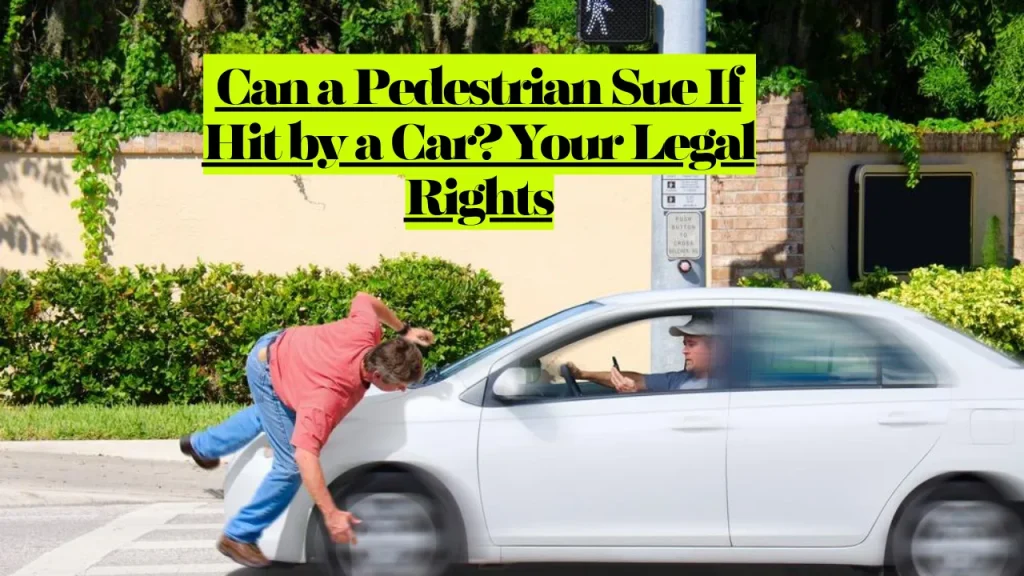Can a Pedestrian Sue If Hit by a Car? Your Legal Rights
Can a pedestrian sue if hit by a car? Yes, pedestrians can sue drivers who hit them, and in most cases, the driver is legally liable for injuries and damages. Pedestrians have the right to file personal injury lawsuits to recover compensation for medical bills, lost wages, pain and suffering, and other losses. The key is proving the driver’s negligence caused your injuries, which typically involves showing they violated traffic laws or failed to exercise reasonable care while operating their vehicle.
Understanding Your Legal Rights as a Pedestrian
When a car strikes a pedestrian, the injured person has several legal options for pursuing compensation. Most pedestrian accident cases are resolved through insurance claims, but lawsuits become necessary when insurance companies refuse fair settlements or liability is disputed.
Why Pedestrians Usually Win
Drivers owe a duty of care to all road users, including pedestrians. This means they must:
- Obey traffic signals and speed limits
- Yield to pedestrians in crosswalks
- Watch for pedestrians when turning
- Avoid distractions like texting while driving
- Exercise extra caution in areas with heavy foot traffic
When drivers breach this duty and cause injuries, they’re typically held liable regardless of where the pedestrian was walking.
When Can You Sue After Being Hit by a Car?
You can file a lawsuit if you were injured by a driver’s negligent or reckless behavior. Common grounds for pedestrian lawsuits include:
Driver Negligence
- Distracted driving: Texting, eating, or using a phone while driving
- Speeding: Driving too fast for conditions or above posted limits
- Failing to yield: Not stopping for pedestrians in crosswalks
- Running red lights or stop signs: Violating traffic control devices
- Impaired driving: Operating a vehicle under the influence of alcohol or drugs
- Aggressive driving: Tailgating, weaving through traffic, or road rage
Proving Negligence
To win a pedestrian accident lawsuit, you must establish four elements:
- Duty: The driver owed you a duty of care
- Breach: The driver violated that duty through negligent actions
- Causation: The driver’s breach directly caused your injuries
- Damages: You suffered actual losses (medical bills, lost income, pain)
Understanding personal injury negligence standards is crucial for building a strong case.
What If You Weren’t in a Crosswalk?
Many pedestrians worry they can’t sue if they weren’t in a designated crosswalk. However, drivers still have a duty to watch for pedestrians everywhere, not just at marked crossings.
Crosswalk vs. Non-Crosswalk Accidents
In a crosswalk: Drivers are almost always liable when hitting a pedestrian in a marked crosswalk, as pedestrians have the right of way.
Outside a crosswalk: You can still recover compensation, but comparative negligence may reduce your award. Courts will examine:
- Whether you crossed at a reasonable location
- Visibility conditions at the time
- Whether the driver could have avoided hitting you
- If you were jaywalking or crossing against signals
Most states use comparative negligence rules, meaning your compensation is reduced by your percentage of fault. For example, if you’re found 20% at fault for jaywalking, your $100,000 award would be reduced to $80,000.
Related Articl: What Happens If You Hit a Pedestrian and They Walk Away? Your Legal Responsibilities and Potential Consequences

Common Pedestrian Accident Injuries
Pedestrian-car collisions often result in severe injuries due to the lack of protection for the human body against a motor vehicle. Understanding common injuries helps you recognize the seriousness of your situation and the potential value of your claim.
Severe Injuries Frequently Seen
Traumatic Brain Injuries (TBI) Even at low speeds, impacts can cause concussions, skull fractures, or permanent brain damage affecting cognitive function, memory, and personality.
Spinal Cord Injuries These can result in partial or complete paralysis, requiring lifelong medical care and dramatically impacting quality of life.
Broken Bones and Fractures Common fractures include:
- Leg and hip fractures
- Arm and wrist fractures
- Pelvic fractures
- Rib fractures
Soft Tissue Injuries Sprains, strains, torn ligaments, and muscle damage may seem minor initially but can cause chronic pain and mobility issues.
Internal Injuries Internal bleeding, organ damage, and internal trauma may not be immediately apparent but can be life-threatening without prompt medical treatment.
Road Rash and Lacerations Severe skin abrasions requiring extensive treatment and potentially causing permanent scarring or disfigurement.
The severity of these injuries often depends on the vehicle’s speed, size, and point of impact. Even low-speed collisions can cause serious harm to unprotected pedestrians.
Types of Compensation Available
Pedestrians injured by vehicles can recover various types of damages depending on the severity of their injuries and circumstances.
Economic Damages
These cover measurable financial losses:
- Medical expenses: Emergency room visits, surgeries, hospitalization, medications, physical therapy, and future medical care
- Lost wages: Income lost while recovering from injuries
- Loss of earning capacity: If injuries prevent you from working in your previous occupation
- Property damage: Damaged clothing, phones, or other personal items
- Rehabilitation costs: Physical therapy, occupational therapy, and ongoing treatment
Important Note: Insurance claims typically only cover economic losses like medical bills and lost wages. If you want compensation for pain and suffering or other non-economic damages, you must file a lawsuit rather than relying solely on the insurance claim process.
Non-Economic Damages
These compensate for intangible losses:
- Pain and suffering: Physical discomfort and emotional distress
- Loss of enjoyment of life: Inability to participate in activities you previously enjoyed
- Emotional distress: Anxiety, depression, or PTSD following the accident
- Disfigurement or scarring: Permanent physical changes from injuries
- Loss of consortium: Impact on relationships with spouse or family
Punitive Damages
In cases involving extreme recklessness or intentional conduct, courts may award punitive damages to punish the driver and deter similar behavior. Examples include:
- Drunk driving accidents
- Hit-and-run incidents
- Deliberately striking a pedestrian
Wrongful Death Claims
If a pedestrian dies from their injuries, certain family members can file wrongful death lawsuits. Those eligible to file typically include:
- Spouse or domestic partner
- Children
- Grandchildren (in some circumstances)
- Dependent minor relatives
- Heirs under state intestate succession laws
Wrongful death claims can recover:
- Medical expenses before death
- Funeral and burial costs
- Loss of financial support
- Loss of companionship and consortium
- Pain and suffering endured before death
Learning about types of damages in personal injury cases helps you understand what compensation you may be entitled to.
Time Limits for Filing a Lawsuit
Every state has a statute of limitations that sets a deadline for filing personal injury lawsuits. Missing this deadline typically means losing your right to sue permanently.
Common State Deadlines
- New York: 3 years from the date of injury
- California: 2 years from the date of injury
- Texas: 2 years from the date of injury
- Florida: 4 years from the date of injury (reduced to 2 years for accidents after March 24, 2023)
- Ohio: 2 years from the date of injury
- Georgia: 2 years from the date of injury
Some exceptions can extend or shorten these deadlines:
- Injuries to minors may have extended deadlines
- Cases involving government vehicles may have shorter notice requirements
- Discovery of injuries later may start the clock from when you discovered the harm
Always consult with an attorney promptly to ensure you don’t miss critical deadlines.
Insurance Claims vs. Lawsuits
Most pedestrian accident cases don’t require going to court. Insurance companies often settle claims before lawsuits become necessary.
The Insurance Claim Process
- Report the accident: File a claim with the driver’s auto insurance
- Provide documentation: Submit medical records, police reports, and evidence
- Negotiate settlement: The insurance company makes an offer
- Accept or reject: If the offer is fair, you settle; if not, you may file a lawsuit
When to File a Lawsuit
Consider filing a lawsuit when:
- The insurance company denies your claim
- The settlement offer doesn’t cover your losses
- Liability is disputed
- The driver was uninsured or underinsured
- Your injuries are severe and require maximum compensation
- The insurance company acts in bad faith
Understanding insurance claim procedures helps you navigate the process effectively.
Who Can You Sue?
Depending on the circumstances, you may be able to sue multiple parties:
The Driver
The most common defendant in pedestrian accident lawsuits is the driver who hit you.
Vehicle Owner
If the driver doesn’t own the vehicle, you can also sue the owner under theories like:
- Negligent entrustment: Allowing an incompetent or reckless person to drive
- Vicarious liability: In some states, owners are automatically liable for accidents involving their vehicles
The Driver’s Employer
If the driver was working at the time of the accident, their employer may be liable under:
- Respondeat superior: Employers are responsible for employees’ actions during work hours
- Negligent hiring or supervision: If the employer knew the driver was dangerous
Government Entities
If poor road conditions, missing signage, or defective traffic signals contributed to the accident, you may have a claim against the government entity responsible for road maintenance. However, special rules and shorter deadlines apply to government claims.
Vehicle Manufacturers
In rare cases involving vehicle defects (like faulty brakes or unintended acceleration), you might sue the manufacturer.
What If the Driver Fled the Scene?
Hit-and-run pedestrian accidents present unique challenges, but you still have options:
Uninsured Motorist Coverage
Your own auto insurance policy may include uninsured motorist coverage that covers pedestrian accidents, even if you weren’t in a vehicle. This coverage can compensate you when the at-fault driver can’t be identified or doesn’t have insurance.
Crime Victim Compensation
Many states offer crime victim compensation programs that provide financial assistance to hit-and-run victims for:
- Medical expenses
- Lost wages
- Counseling services
- Funeral costs (in fatal accidents)
Finding the Driver
Police investigations, surveillance cameras, and witness statements may eventually identify the driver, allowing you to pursue a claim later.
When Pedestrians May Be at Fault
While drivers are usually liable, pedestrians can sometimes share fault or be primarily responsible for accidents.
Scenarios Where Pedestrians May Bear Fault
- Jaywalking: Crossing outside designated areas against traffic signals
- Darting into traffic: Suddenly entering the roadway without warning
- Walking on highways: Being on roadways where pedestrians are prohibited
- Intoxication: Being under the influence and stumbling into traffic
- Ignoring signals: Crossing against “Don’t Walk” signals
- Distracted walking: Texting or wearing headphones that prevent hearing approaching vehicles
Comparative Negligence Impact
Even if you’re partially at fault, you can still recover compensation in most states. Two main systems exist:
Modified Comparative Negligence (50% or 51% bar)
- You can’t recover if you’re 50% or 51% or more at fault (depending on state)
- Common in states like Illinois, Wisconsin, and Colorado
Pure Comparative Negligence
- You can recover even if you’re 99% at fault, but your award is reduced proportionally
- Used in states like California, New York, Florida, and Oregon
- These states allow shared fault where both the pedestrian and driver can be assigned percentages of blame
Steps to Take After Being Hit by a Car
Taking proper action immediately after an accident strengthens your legal case:
At the Scene
- Call 911: Get police and medical help immediately
- Stay put: Don’t leave the scene (unless going to the hospital)
- Document everything: Take photos of the scene, vehicles, injuries, and road conditions
- Get information: Collect the driver’s name, insurance, license plate, and contact info
- Find witnesses: Get names and phone numbers of anyone who saw the accident
- Don’t admit fault: Avoid saying “I’m sorry” or accepting blame
After the Scene
- Seek medical treatment: See a doctor even if you feel fine; some injuries appear later
- Keep records: Save all medical bills, prescriptions, and documentation
- Report to insurance: Notify your insurance company about the accident
- Consult an attorney: Speak with a personal injury lawyer before accepting any settlement
Common Questions About Pedestrian Lawsuits
How long does a pedestrian lawsuit take?
Most cases settle within 6-18 months, but complex cases involving serious injuries or disputed liability can take 2-3 years or longer if they go to trial.
Do I need a lawyer to sue after being hit by a car?
While not legally required, hiring an experienced personal injury attorney significantly increases your chances of fair compensation. Lawyers handle negotiations, gather evidence, and represent you in court if necessary. Most work on contingency, meaning they only get paid if you win.
What if I don’t have health insurance?
You can still pursue a lawsuit. Many attorneys can help you find doctors who treat on a lien basis (payment comes from your settlement). Additionally, the driver’s insurance may cover immediate medical bills under medical payments coverage.
Can I sue if the driver has no insurance?
Yes. You can file a lawsuit directly against the uninsured driver, though collecting damages may be difficult if they lack assets. Your own uninsured motorist coverage provides another avenue for compensation.
What’s the average settlement for being hit by a car?
Settlement amounts vary dramatically based on injury severity, lost wages, and state laws. Minor injuries might settle for $10,000-$50,000, while catastrophic injuries can result in millions. Factors affecting settlement value include:
- Severity and permanence of injuries
- Total medical costs
- Lost earning capacity
- Pain and suffering
- Quality of evidence
- Defendant’s insurance limits
Can I sue if the accident was partially my fault?
In most states, yes. Comparative negligence laws allow you to recover compensation even if you share some fault, though your award will be reduced by your percentage of responsibility.
What if the driver claims I came out of nowhere?
Drivers have a duty to maintain proper lookout for pedestrians at all times. “I didn’t see them” is rarely a valid defense. Your attorney will gather evidence like witness statements, surveillance video, and accident reconstruction to prove the driver should have seen you.
Maximizing Your Compensation
To get the full value you deserve:
- Don’t accept the first offer: Insurance companies typically offer low initial settlements
- Document everything: Keep detailed records of all expenses and impacts
- Don’t give recorded statements: Insurance adjusters may use your words against you
- Don’t post on social media: Posts about your accident can be used to undermine your claim
- Be patient: Settling too quickly may mean accepting less than your case is worth
- Follow medical advice: Missing appointments or refusing treatment can hurt your case
When to Contact an Attorney
Consider contacting a pedestrian accident lawyer immediately if:
- Your injuries are serious or permanent
- You’ve accumulated significant medical bills
- The insurance company denies your claim or offers inadequate compensation
- Liability is disputed
- Multiple parties may be responsible
- The accident involved a government vehicle or entity
- You’re unsure about your legal rights
Most personal injury attorneys offer free consultations and work on contingency, so there’s no upfront cost to get professional legal advice.
Understanding Contingency Fees
Personal injury lawyers typically work on a contingency fee basis, meaning:
- You pay nothing upfront
- The lawyer only gets paid if you win your case
- Legal fees are a percentage of your settlement or award (typically 33-40%)
- If you don’t recover compensation, you don’t owe attorney fees
This arrangement makes legal representation accessible to everyone, regardless of financial situation, and motivates your attorney to secure the maximum possible compensation.
Legal Disclaimer: This article provides general information about pedestrian accident lawsuits for educational purposes only and does not constitute legal advice. Laws vary significantly by state and individual circumstances. Specific outcomes depend on the facts of each case, applicable state laws, and the quality of evidence. Always consult with a qualified personal injury attorney licensed in your jurisdiction for advice specific to your situation.
Resources:
- National Highway Traffic Safety Administration: nhtsa.gov
- American Bar Association Lawyer Referral: 1-800-285-2221
- State Bar Association: Contact your state’s bar for local attorney referrals
About the Author

Sarah Klein, JD, is a former civil litigation attorney with over a decade of experience in contract disputes, small claims, and neighbor conflicts. At All About Lawyer, she writes clear, practical guides to help people understand their civil legal rights and confidently handle everyday legal issues.
Read more about Sarah
